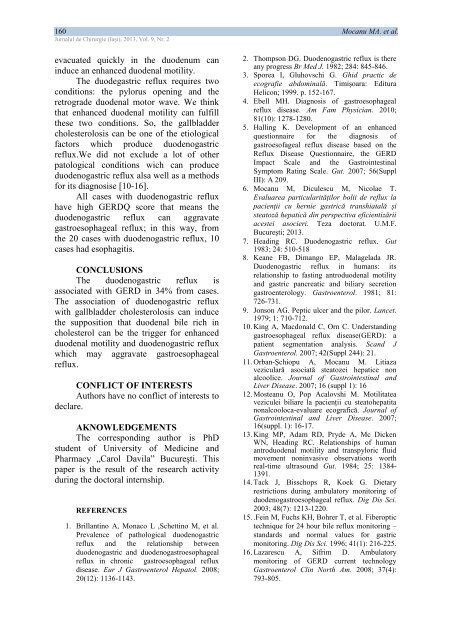PDF (5 MB) - Jurnalul de Chirurgie
PDF (5 MB) - Jurnalul de Chirurgie
PDF (5 MB) - Jurnalul de Chirurgie
You also want an ePaper? Increase the reach of your titles
YUMPU automatically turns print PDFs into web optimized ePapers that Google loves.
160 Mocanu MA. et al.<strong>Jurnalul</strong> <strong>de</strong> <strong>Chirurgie</strong> (Iaşi), 2013, Vol. 9, Nr. 2evacuated quickly in the duo<strong>de</strong>num caninduce an enhanced duo<strong>de</strong>nal motility.The duo<strong>de</strong>gastric reflux requires twoconditions: the pylorus opening and theretrogra<strong>de</strong> duo<strong>de</strong>nal motor wave. We thinkthat enhanced duo<strong>de</strong>nal motility can fulfillthese two conditions. So, the gallblad<strong>de</strong>rcholesterolosis can be one of the etiologicalfactors which produce duo<strong>de</strong>nogastricreflux.We did not exclu<strong>de</strong> a lot of otherpatological conditions wich can produceduo<strong>de</strong>nogastric reflux alsa well as a methodsfor its diagnosise [10-16].All cases with duo<strong>de</strong>nogastric refluxhave high GERDQ score that means theduo<strong>de</strong>nogastric reflux can aggravategastroesophageal reflux; in this way, fromthe 20 cases with duo<strong>de</strong>nogastric reflux, 10cases had esophagitis.CONCLUSIONSThe duo<strong>de</strong>nogastric reflux isassociated with GERD in 34% from cases.The association of duo<strong>de</strong>nogastric refluxwith gallblad<strong>de</strong>r cholesterolosis can inducethe supposition that duo<strong>de</strong>nal bile rich incholesterol can be the trigger for enhancedduo<strong>de</strong>nal motility and duo<strong>de</strong>nogastric refluxwhich may aggravate gastroesophagealreflux.CONFLICT OF INTERESTSAuthors have no conflict of interests to<strong>de</strong>clare.AKNOWLEDGEMENTSThe corresponding author is PhDstu<strong>de</strong>nt of University of Medicine andPharmacy „Carol Davila” Bucureşti. Thispaper is the result of the research activityduring the doctoral internship.REFERENCES1. Brillantino A, Monaco L ,Schettino M, et al.Prevalence of pathological duo<strong>de</strong>nogastricreflux and the relationship betweenduo<strong>de</strong>nogastric and duo<strong>de</strong>nogastroesophagealreflux in chronic gastroesophageal refluxdisease. Eur J Gastroenterol Hepatol. 2008;20(12): 1136-1143.2. Thompson DG. Duo<strong>de</strong>nogastric reflux is thereany progress Br Med J. 1982; 284: 845-846.3. Sporea I, Gluhovschi G. Ghid practic <strong>de</strong>ecografie abdominală. Timişoara: EdituraHelicon; 1999. p. 152-167.4. Ebell MH. Diagnosis of gastroesophagealreflux disease. Am Fam Physician. 2010;81(10): 1278-1280.5. Halling K. Development of an enhancedquestionnaire for the diagnosis ofgastroesofageal reflux disease based on theReflux Disease Questionnaire, the GERDImpact Scale and the GastrointestinalSymptom Rating Scale. Gut. 2007; 56(SupplIII): A 209.6. Mocanu M, Diculescu M, Nicolae T.Evaluarea particularităţilor bolii <strong>de</strong> reflux lapacienţii cu hernie gastrică transhiatală şisteatoză hepatică din perspectiva eficientizăriiacestei asocieri. Teza doctorat. U.M.F.Bucureşti; 2013.7. Heading RC. Duo<strong>de</strong>nogastric reflux. Gut1983; 24: 510-5188. Keane FB, Dimango EP, Malagelada JR.Duo<strong>de</strong>nogastric reflux in humans: itsrelationship to fasting antroduo<strong>de</strong>nal motilityand gastric pancreatic and biliary secretiongastroenterology. Gastroenterol. 1981; 81:726-731.9. Jonson AG. Peptic ulcer and the pilor. Lancet.1979; 1: 710-712.10. King A, Macdonald C, Orn C. Un<strong>de</strong>rstandinggastroesophageal reflux disease(GERD): apatient segmentation analysis. Scand JGastroenterol. 2007; 42(Suppl 244): 21.11. Orban-Şchiopu A, Mocanu M. Litiazaveziculară asociată steatozei hepatice nonalcoolice. Journal of Gastrointestinal andLiver Disease. 2007; 16 (suppl 1): 1612. Mosteanu O, Pop Acalovshi M. Motilitateaveziculei biliare la pacienţii cu steatohepatitanonalcooloca-evaluare ecografică. Journal ofGastrointestinal and Liver Disease. 2007;16(suppl. 1): 16-17.13. King MP, Adam RD, Pry<strong>de</strong> A, Mc DickenWN, Heading RC. Relationships of humanantroduo<strong>de</strong>nal motility and transpyloric fluidmovement noninvasive observations worthreal-time ultrasound Gut. 1984; 25: 1384-1391.14. Tack J, Bisschops R, Koek G. Dietaryrestrictions during ambulatory monitoring ofduo<strong>de</strong>nogastroesophageal reflux. Dig Dis Sci.2003; 48(7): 1213-1220.15. .Fein M, Fuchs KH, Bohrer T, et al. Fiberoptictechnique for 24 hour bile reflux monitoring –standards and normal values for gastricmonitoring. Dig Dis Sci. 1996; 41(1): 216-225.16. Lazarescu A, Sifrim D. Ambulatorymonitoring of GERD current technologyGastroenterol Clin North Am. 2008; 37(4):793-805.
















